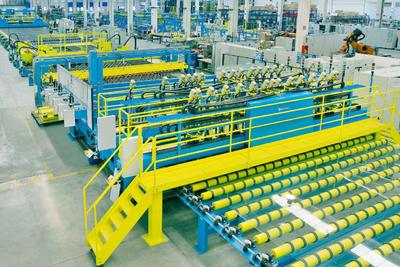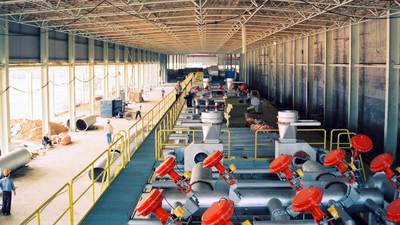Glass Forming
Forming Technology
Flat glass is manufactured using one of three processes: the sheet process, the plate process, or the float process. The float glass process has, almost entirely, replaced the sheet glass and plate glass processes.Sheet Glass
The sheet glass process began with the mechanically drawing cylinder process, where large glass cylinders were made to be split and flattened into plates, and has developed into continuous vertical drawing processes. These processes depend on the stretching and cooling of viscous glass, and their produced glass typically has a desirable bright and transparent "fire finish" due to the surfaces of the glass ribbon cooling down without contact with solid forming elements until they are relatively hard. However, in stretching the molten glass, small differences in viscosity due to chemical and thermal in-homogeneity give rise to thickness variations in the glass ribbon which cause undesirable optical distortions.Plate Glass
The plate glass process was an early process of casting molten glass onto a metal table and rolling it into a plate. Manufacturers improved the process by continuously rolling a glass ribbon between water-cooled rollers. This forming process yields surfaces which copy any undesired imperfections of the forming machines; consequently, the glass must be mechanically ground and polished to produce a transparent, smooth sheet of glass. Plate glass has a plain polished surface with a high degree of parallelism and is generally free from the optical distortion of the less expensive sheet glass.Float Glass
Sir Alistair Pilkington conceived the float process as a means of combining the brilliant fire-finish of sheet glass with the freedom from optical distortion of plate glass. It has substantially replaced the plate and sheet processes worldwide since its introduction in 1959.|
|
| A StewartFloat® tin bath |
StewartFloat® Tin Bath Technology
From the working end of the melting furnace, glass flows through the canal area into the StewartFloat® tin bath.This tin bath consists of support steel, upper and lower casings, refractory liner, molten tin, heating elements, a reducing atmosphere, temperature sensors, temperature and flow control systems and is typically 8m wide and 60m in length. It is designed to control heat flow balance, desired ribbon width and thickness, and glass optical quality. The float bath contains nearly two-hundred tons of molten tin at an average temperature of 800°C (1472°F).
A continuous stream of molten glass, at a temperature of around 1050°C, is poured onto the bath of molten tin. Movement along the bath is created by the tractive force that is applied by a roller conveyor. This force transports the formed ribbon from the bath and through the annealing lehr.
The tin bath maintains the molten glass ribbon at a high enough temperature and for a sufficient amount of time to spread laterally and "float" out any surface irregularities. As the glass thickness falls towards the equilibrium value of 6mm thickness the rate of spreading decreases, and thickness and width then decrease under the stretching influence of the conveyor rollers. As the ribbon moves further along the bath, it is progressively cooled, until it is rigid enough to be bent and lifted from the bath by the conveyor rollers without breaking or damaging the continuous glass ribbon.
For thin or thick glass ribbons (other than the equilibrium thickness of 6mm) pairs of driven toothed wheels—called top rollers—are applied to the top surface of the ribbon edges. The top rollers, which can be angled with respect to the longitudinal tractive force, grip the ribbon and apply a force which can control ribbon width and thickness.
Float Material Selection
Molten tin is the premier material to support glass in the float process. Pure tin provides a combination of properties uniquely suited to the process. Despite an extensive search, no better pure metal or alloy has been identified that meets the following material requirements:- The metal must be liquid in a temperature range between 530°C and 1050°C
- Must have a density higher than that of glass so that the glass floats
- The vapor pressure of the molten metal, at high temperature, should be as low as possible
- It must have the minimal interaction with glass
- The metal must be readily available
Molten tin, like other materials, does introduce complications. It oxidizes rapidly when exposed to oxygen; therefore, a carefully controlled reducing atmosphere composed of a blend of nitrogen and hydrogen is introduced to the tin bath, keeping the entire bath at a positive pressure.
Float glass products are manufactured daily in a thickness range of 0.4mm to 12mm using StewartFloat® Tin Baths.









